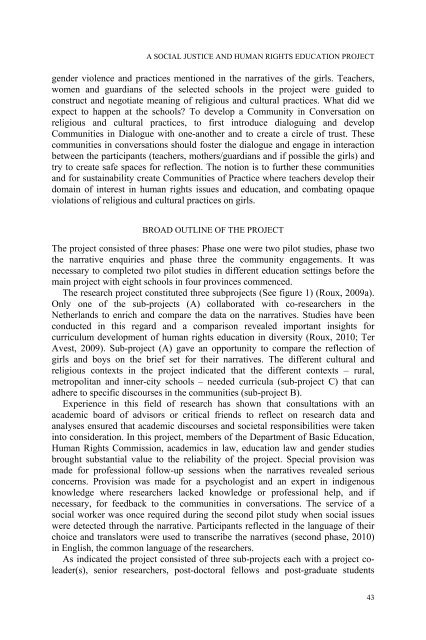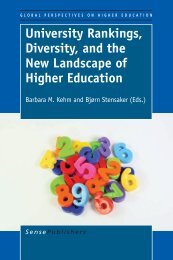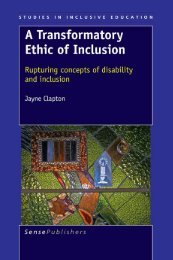Safe Spaces Human Rights Education in Diverse Contexts
Safe Spaces Human Rights Education in Diverse Contexts
Safe Spaces Human Rights Education in Diverse Contexts
Create successful ePaper yourself
Turn your PDF publications into a flip-book with our unique Google optimized e-Paper software.
A SOCIAL JUSTICE AND HUMAN RIGHTS EDUCATION PROJECT<br />
gender violence and practices mentioned <strong>in</strong> the narratives of the girls. Teachers,<br />
women and guardians of the selected schools <strong>in</strong> the project were guided to<br />
construct and negotiate mean<strong>in</strong>g of religious and cultural practices. What did we<br />
expect to happen at the schools? To develop a Community <strong>in</strong> Conversation on<br />
religious and cultural practices, to first <strong>in</strong>troduce dialogu<strong>in</strong>g and develop<br />
Communities <strong>in</strong> Dialogue with one-another and to create a circle of trust. These<br />
communities <strong>in</strong> conversations should foster the dialogue and engage <strong>in</strong> <strong>in</strong>teraction<br />
between the participants (teachers, mothers/guardians and if possible the girls) and<br />
try to create safe spaces for reflection. The notion is to further these communities<br />
and for susta<strong>in</strong>ability create Communities of Practice where teachers develop their<br />
doma<strong>in</strong> of <strong>in</strong>terest <strong>in</strong> human rights issues and education, and combat<strong>in</strong>g opaque<br />
violations of religious and cultural practices on girls.<br />
BROAD OUTLINE OF THE PROJECT<br />
The project consisted of three phases: Phase one were two pilot studies, phase two<br />
the narrative enquiries and phase three the community engagements. It was<br />
necessary to completed two pilot studies <strong>in</strong> different education sett<strong>in</strong>gs before the<br />
ma<strong>in</strong> project with eight schools <strong>in</strong> four prov<strong>in</strong>ces commenced.<br />
The research project constituted three subprojects (See figure 1) (Roux, 2009a).<br />
Only one of the sub-projects (A) collaborated with co-researchers <strong>in</strong> the<br />
Netherlands to enrich and compare the data on the narratives. Studies have been<br />
conducted <strong>in</strong> this regard and a comparison revealed important <strong>in</strong>sights for<br />
curriculum development of human rights education <strong>in</strong> diversity (Roux, 2010; Ter<br />
Avest, 2009). Sub-project (A) gave an opportunity to compare the reflection of<br />
girls and boys on the brief set for their narratives. The different cultural and<br />
religious contexts <strong>in</strong> the project <strong>in</strong>dicated that the different contexts – rural,<br />
metropolitan and <strong>in</strong>ner-city schools – needed curricula (sub-project C) that can<br />
adhere to specific discourses <strong>in</strong> the communities (sub-project B).<br />
Experience <strong>in</strong> this field of research has shown that consultations with an<br />
academic board of advisors or critical friends to reflect on research data and<br />
analyses ensured that academic discourses and societal responsibilities were taken<br />
<strong>in</strong>to consideration. In this project, members of the Department of Basic <strong>Education</strong>,<br />
<strong>Human</strong> <strong>Rights</strong> Commission, academics <strong>in</strong> law, education law and gender studies<br />
brought substantial value to the reliability of the project. Special provision was<br />
made for professional follow-up sessions when the narratives revealed serious<br />
concerns. Provision was made for a psychologist and an expert <strong>in</strong> <strong>in</strong>digenous<br />
knowledge where researchers lacked knowledge or professional help, and if<br />
necessary, for feedback to the communities <strong>in</strong> conversations. The service of a<br />
social worker was once required dur<strong>in</strong>g the second pilot study when social issues<br />
were detected through the narrative. Participants reflected <strong>in</strong> the language of their<br />
choice and translators were used to transcribe the narratives (second phase, 2010)<br />
<strong>in</strong> English, the common language of the researchers.<br />
As <strong>in</strong>dicated the project consisted of three sub-projects each with a project coleader(s),<br />
senior researchers, post-doctoral fellows and post-graduate students<br />
43














